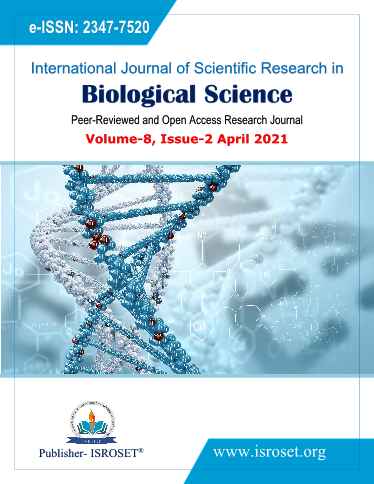Fungal and Bacterial Species Associated with the Deterioration of Fresh Tomato Fruits (Lycopersium esculentum M.) Sold in Aliero Market, Kebbi State
Keywords:
Tomatoes, microorganisms, mean, market and AlieroAbstract
Lycopersium esculentum M. are economic vegetables that deteriorated due to the nutrients contain which allowed the growth of microorganisms on it. Bacterial and fungal species were identified using poured plate method and Biochemical tests. Three (3) categories of tomato fruits samples were collected, varying different degrees of spoilage; highly rotten, slightly rotten and fresh tomatoes. A total of sixty (60) tomatoes were randomly collected within Aliero central market. From the results obtained, seven fungal species and four (4) bacterial species were isolated namely; Saccharomyces cerevisiae, Candida species, Alternaria alternate, Trichoderma species, Penicillium digitatum, Mucor species and Aspergillus species and bacterial species identified were; Bacillus species, Escherichia coli, Staphylococcus aureus and Proteus species. The mean colony counts of bacteria ranges from 2.9 x 103 to 6.0 x 102 cfu/g and spore formed per unit for fungal species ranged from 3.0 x 103 to 5.6 x 102 sfu/g. In conclusion, these spoilage of fresh tomato usually occurs during storage and transit as well as during processing. Since many microorganisms were identified as the major causal agents of the tomato fruits spoilage in the study area, proper handling procedure especially during post-harvest and pre harvest as well as during selling and buying of the tomato fruits should be employed to avoid damage that usually results to the spoilage of these vital vegetable.
References
J.N. Keta, S.A. Shinkafi, M.N. Keta, M. Abubakar, M. Aminu, R.J. Patrick, G.J. Gudu, Fungal Foliar Pathogens of Tomato (Lycopersicum esculentum M.) in Birnin Kebbi Local Government Area, Kebbi State, Nigeria. International Journal of Science for Global Sustainability, Vol. 6 (2): 134-140, 2020.
R.A Baiyewu, N.A Amusa, O.A Ayoola, O.O Babalola, Survey of the postharvest diseases and aflatoxin Contamination of marketed pawpaw fruit (Carica papaya L) in South Western Nigeria. African Journal of Agricultural Research, 2(4), 178-181, 2007.
J. Sravanthi, S.R Ganghar, Phytochemocal and antioxidant composition in Lycopersium esculentum. Journal of medicinal plant studies, 3(4):87-93, 2015.
S Kimura, N, Sinha, Tomato (Solanum lycopersicum): A model fruit Bearing crop. CSH Protoc. Doi: 10.1101/pdb.emo P. 105, 2008.
O.B Bashir, U Habib, O.J Odunayo, A.S Opeyemi, A.H Alafe, T.M Owode, Microorganisms causing postharvest tomato fruit decay in Nigeria. Journal of Entomology and Zoology Studies 4(1): 374-377, 2006.
M Barth, T.P Hankinson, H. Zhuang, F Breidt, Microbiological Spoilage of Fruits and Vegetables in W.H.Sperber, M.P.Doyle (editions), Compendium of the Microbiological Spoilage of Foods and Beverages, Food Microbiology and safety. Cspringer science + Business Media, LLC, 13183, 2010.
N,E Dimphna, Isolation and Identification of Fungi Associated with Postharvest Decay of Lycopersicum esculentum M. sold in Abakaliki, Nigeria. Journal of Agriculture and Veterinary Science, Volume 9, Issue 7: 87-89, 2016.
M Abubakar, S Dharmendra, A Hamisu, J.N Keta, J.A Amina, Identification and Assessment of the Effects of Pathogenic Fungi Associated With The Spoilage of Tomato Fruits in Jega Local Government Area, Kebbi State, Nigeria. Journal of Innovative Research in Life Sciences, Vol. 1(2): 47-54, 2019.
NPC National Population Commission NPC, Census report. Abuja, Nigeria, 2006.
Uzondo-Chimeziri, Udo-Obong, The Life and People of (Kebbi State Government printing press), pp. 1-64 Venomous Animals and Toxins, 2:6-12, 2007
M, Cheesebrough, Medical Laboratory Manual Tropical Health Technology, low priced edition. Doddington, Cambrigdeshire, England. Pp.20-35, 2014
C.O. Ugwu, F.O Chukwuezi, V.C.O Ozougwu, Microbial Agents of tomato spoilage in Onitsha metropolis. Advances in Biological Research, 8(2):87-93, 2014.
I.A. Onoharigho, A.A. Ogunjobi, The Activities of Rhizosphere Bacteria in Improving the Growth of Habanero Pepper (Capsicum chinense Jacq.) and Soil Fertility. International Journal of Scientific Research in Biological Sciences. Vol.7, Issue.6, pp.113 119,2020.
J.Y. Ijato, A.O. Adebiyi, J.A. Ijadunola, Antifungal Effects of Four Trofical Plant Aqueous and Ethanol Extracts on Postharvest Rot of Tomato (Lycopersicumes culentum), New York Science Journal, 4(1):64-68, 2011.
K. Fatih, A.U. Tamer, M. Oskay, Determination of Fungi Associated with Tomatoes (Lycopersicum esculentum M.) and Tomato Pastes. Plant Pathology Journal, 4(4): 146-149, 2005.
S.T. Hammond, J.H. Brown, J.R. Burger, T.P. Flanagan, T.S. Fristoe, N. Mercado?Silva, J.G. Okie, Food spoilage, storage, and transport: Implications for a sustainable future. Bio Science, 65(8), PP. 758– 768, 2015.
P. Rodriquez, C. Soares, Z. Kozakiewicz, R.R.M. Paterson, N. Lima, A. Venancio, Identification and Characterization of Aspergillus flavus and toxins. Communicating Current Research and Educational topics and trends in Applied Microbiology 527534, 2017.
O.O. Akinmusire, Fungi Species Associated with the Spoilage of some Edible Fruits in Maiduguri, North eastern Nigeria. Advances in Environmental Biology, 5(1): PP. 157-161, 2011.
Downloads
Published
How to Cite
Issue
Section
License

This work is licensed under a Creative Commons Attribution 4.0 International License.
Authors contributing to this journal agree to publish their articles under the Creative Commons Attribution 4.0 International License, allowing third parties to share their work (copy, distribute, transmit) and to adapt it, under the condition that the authors are given credit and that in the event of reuse or distribution, the terms of this license are made clear.







